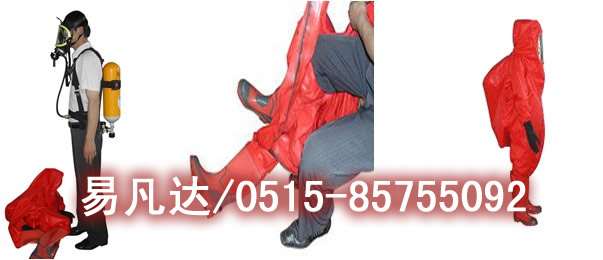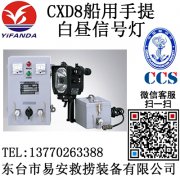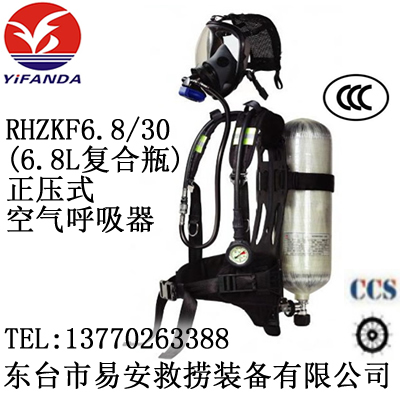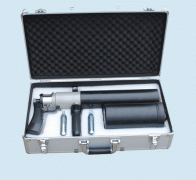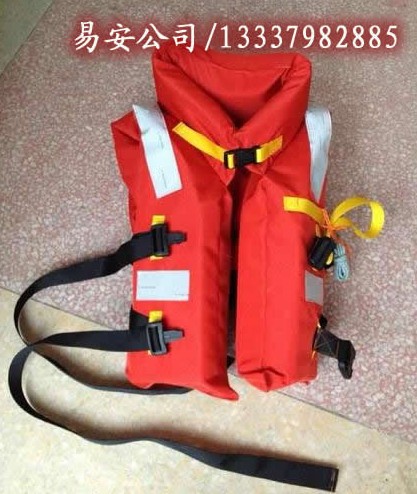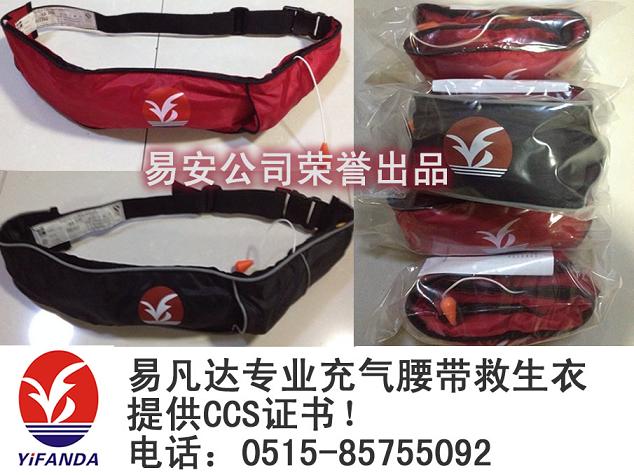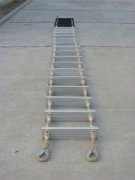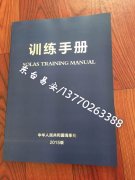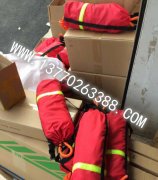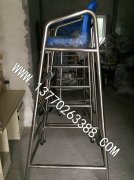您正在访问的是
RFH-02 气密型(重型)防化服使用说明书,具体信息如下:
感谢您选购本公司产品,为了您的安全和健康,以及相应延长产品的使用寿命,在使用前请详细阅读本说明书。
本公司生产的RFH-02气密型(重型)防化服,都经过严格测试,确保符合BS EN943-1:2002 的欧洲标准,所采用的材料也经过严格测试,保证符合BS EN943-1:2002 中相关条款的要求。
RFH-02气密型(重型)防化服是消防员防护服装之一,它是消防员在有危险性化学物品和腐蚀性物品的火场和事故现场进行灭火战斗和抢险救援时,为保护自身免遭化学危险品或腐蚀性物质的侵害而穿着的防护服。
RFH-02气密型(重型)防化服主体胶布采用经阻燃增粘处理的锦丝绸布,双面涂覆阻燃防化面胶制成,主体胶布遇火只产生炭化,不溶滴,又能保持良好强度。主体胶布经贴合-缝制-贴条工艺制成服装主体和手套,并配以阻燃、耐电压、抗穿刺靴或消防胶靴构成整套服装。
1 规格尺寸
|
衣 号 |
S |
M |
L |
XL |
|
衣长(领口至靴底)(cm) |
160 |
166 |
171 |
177 |
|
胸 围(cm) |
55 |
56 |
57 |
58 |
|
腰 围(cm) |
115 |
122 |
125 |
126 |
|
鞋 码(cm) |
25 |
26 |
27 |
27 |
|
适合身高(cm) |
165-170 |
170-175 |
175-180 |
180-185 |
2 主要技术参数
(1)主体胶布
胶布厚度 0.45+0.05mm
拉伸强度 经纬向均 不小于450N/5cm
撕裂强度(梯形法经纬向均) 不小于32N
防酸渗透性能(10mm×1h) (80%H2S04,60%HN03,30%HCL) 不渗透
防碱渗透性能(10mm×1h) (6.1mo1/LNa0H) 不渗透
阻燃性能 续烧时间 不大于2s 阻燃时间 不大于10s 损毁长度 不大于10cm
耐热老化性能(125℃×24h) 不粘、不脆
耐寒性能(-25℃×5min折叠180°) 无裂纹
耐汽油性能(浸120#汽油30s) 无裂纹、不发粘
胶层与织物粘合强度 不小于0.78KN/M
(2)消防胶靴性能见下表
|
消防胶靴 |
|
1靴面扯断伸长率:≥450% |
|
2靴底耐刺穿性能:≥900N |
|
3靴底耐磨性能:≤0.9cm3/1.61km |
|
4靴子耐油性能:鞋面、鞋底,-2~10% |
|
5粘条粘着力:≥600N/m |
|
6靴底耐电压:≥5000V |
|
7靴面老化后扯断伸长率:≥75% |
|
8钢质衬垫耐腐蚀性能:不腐蚀 |
|
9靴底隔热性能:≤22℃ |
|
10靴子防滑性能:≥115° |
|
11重量:≤1.8kg |
|
12渗漏性能:浸水2h,不渗透 |
(3)成品性能
贴条粘附强度 不小于0.78KN/m
抗渗水性(5只3L/min水喷头冲刷15min) 不渗漏
质量(M) 不大于5kg
3 产品执行标准:Q/320981DFC02-2007《消防防化服》以及BS EN943-1:2002 中相关条款的要求
4 气密型防化服的检查
气密型防化服在每次使用前、放置过程中每六个月都要进行目视检查。每年进行一次气密性检查。
(1)防化服的里外要求没有被污染;
(2)防化服上的标识数字要清晰可见;
(3)拉链要求完好,拉链的搭片也要完好;
(4)防化服面料包括防化服的头罩,不应有撕裂、孔洞,要特别注意接缝部位;
(5)面罩视窗的视觉效果不应受到大的刮擦、磨损痕迹的影响;
(6)我们建议,对减压排气阀进行目视检查,如果阀的隔膜变形或损坏,要立即进行更换。
5 使用方法
尽管穿着防化服需要协穿者(帮助穿着的人)的帮助,当其穿着过程还是相当简单的。
(1)协穿者帮助穿着者背好呼吸装置,并按照呼吸装置使用说明书的要求将供气阀和面罩相连,并启动呼吸装置。
(2)通过调节呼吸装置的背带,调节呼吸器到最舒适的状态。
(3)一条长约128cm的重型气密性拉链从防化服的一侧向下,延伸到小腿处,然后用一只手压住拉链,使其保持平直,而另一只手拉动拉链,将拉链拉开,每次拉动大约61cm,只到将拉链完全拉开,然后将防化服向下折,露出防化靴的顶部。
(4)穿着者首先穿好防化靴,然后将防化服向上拉,将手臂穿到衣袖中,并带好头罩,在协穿者的帮助下带好面罩,并将头部的头带固定好。
(5)协穿者按照步骤(3)的要求将拉链拉好。
(6)重型气密性拉链外有塔边,拉链拉好后将塔边合上,对拉链起保护作用,延长使用寿命。
6 防化服的脱卸
首先对防化服进行彻底的清洁,除去污染物,以使穿者安全的将防化服脱下。在脱卸的过程中需要协穿者的帮助,要特别注意,协穿者要穿着一定的防护服装。
(1)松开或解开呼吸装置的背带。
(2)按照呼吸装置的使用说明关闭呼吸装置。
(3)断开供气阀与面罩的连接,卸下呼吸装置。
(4)放松面罩的头带,以使面罩可以方便的从佩戴者头上取下。
(5)按照与5、(3)中相反的顺序将拉链完全拉开。
(6)协穿者将防化服从头部向下折到背部时,穿着者将手臂从衣袖中拉出。在整个脱卸过程,自始至终请勿接触防化服的外表面。
(7)将防化服向下折,直到露出防化靴的顶部,穿着者可以脱下防化靴。
上述过程一定要在没有任何污染的清洁地方进行。
7 存放时的折叠方法
(1)将防化服正面朝下放置;
(2)将塑料袋从头罩和面罩的上方套下;
(3)将衣袖和衣背塞入塑料袋中;
(4)将裤腿在中间折叠;
(5)将整套防化服向后折叠使面罩朝上;
(6)将防化服放入红色包装箱,面罩朝上放置;
(7)如果红色包装箱被使用,可以用黑色索绳系紧。
8 使用注意事项
(1)消防防化服不得与火焰及熔化物直接接触。
(2)使用前必须认真检查服装有无破损,如有破损,严禁使用。
(3)使用时,必须注意头罩与面具的面罩紧密配合,以保证颈部、胸部气密。腰带必须收紧,以减少运动时的“风箱效应”。
(4)该套防护服只能与自给式空气呼吸器(RHZK)配合使用,而且使用人员要经过专门的训练,完全熟悉该套防护服的使用性能与方法。
(5)该套防护服的制作面料不具透气性,所以使用人员如果出现过度劳累症状,如:头晕、恶心等要立即离开工作现场,并及时脱下该防化服(脱下前要进行必要的清污处理)。
(6)确保使用防化手套和防化靴也要符合相应的标准和要求。
(7)每次使用后,根据脏污情况用肥皂水或0.5-1%的碳酸钠水溶液洗涤,然后用清水冲洗,放在阴凉通风处,晾干后包装。
(8)消防防化服在保存期间严禁受热及阳光照射,不许接触活性化学物质及各种油类。
(9)产品在符合标准规定的保管条件下,保质期为五年。
Manual for the Use of RFH-02 Air-tight Chemical Protective Suits
Thank you for purchasing our company's products, and for your safety and health, please read the manual carefully before using.
RFH-02 Air-tight Chemical Protective Suits produced in our company is strictly detected and is according to the EU standard of BS EN943-1:2002 . The raw materials we use are also detected and is complied to the requirements of the terms in BS EN943-1:2002.
RFH-02 Air-tight Chemical Protective Suits is one kind of the fireman suits which is worn when the firemen fight with fire or rescue in the places where there are dangerous chemicals or caustic things and they use this to protect themselves from the possible harm of the chemicals or the caustic things.
The main part of the rubberized fabric of RFH-02 Air-tight Chemical Protective Suits uses the silk cloth which is processed by flame-retardant and tackifying methods. Both of its two sides are covered with chemical-protective face-glue. The rubberized fabric only carbonizes but without melting drops and keeps good strength when contacting with fire. The rubberized fabric is made into the main part of the suits and gloves through the process of paste, tailoring, and hot-sealing strip. It can also be made into the whole suits by combining with fire-retardant, voltage resistant, anti-puncture boots or fire-fighting boots.
1 Sizes
|
Sizes |
S |
M |
L |
XL |
|
Length(From collar to boots)(cm) |
160 |
166 |
171 |
177 |
|
Chest circumference(cm) |
55 |
56 |
57 |
58 |
|
Waistline(cm) |
115 |
122 |
125 |
126 |
|
Shoe size(cm) |
25 |
26 |
27 |
27 |
|
Body Heights(cm) |
165-170 |
170-175 |
175-180 |
180-185 |
2 Main technical parameters
(1) The main part of the rubberized fabric
The thickness of the rubberized fabric 0.45+0.05mm
The tensile strength average of the Longitude and Latitude not less than 450N/5cm
The tearing strength average of the Longitude and Latitude not less than 32N
The performance of Anti-sour penetration (10mm×1h)(80%H2S04,60%HN03,30%HCL) No penetration
The performance of Anti-sour penetration (6.1mo1/LNa0H) No penetration
The performance of fire retardant the lasting time of burning not over 2s
The time of stopping fire not over 10s the length destroyed not over 10cm
Anti-aging caused by hot (125℃×24h)not pitchy, not brittle
The performance of anti-coldness (-25℃×5minfolded to 180°)without cracks
The performance of anti-petrol (soaked in120#petrol for 30s)no cracks nor pitchy
The adherisive strength between the fabric and the glue not less than 0.78KN/M
(2) The table below is the performance of fire-fighting boots
|
Fire-fighting boots |
|
1 The rate of the tearing length of the boots surface:≥450% |
|
2 The performance of anti- penetration of the boots bottom:≥900N |
|
3 The performance of anti- wear of the boots bottom:≤0.9cm3/1.61km |
|
4 The performance of anti- oil of the boots bottom:surface and bottom of the shoes,-2~10% |
|
5 The strength of sticky of the sticky strips:≥600N/m |
|
6 The anti-voltage of the boots bottom:≥5000V |
|
7 The tearing length of the shoe surface after aging :≥75% |
|
8 The performance of anti-corrosion of the steel gasket No corrosion |
|
9 The performance of anti-hot of the boots bottom:≤22℃ |
|
10 The performance of anti-slippery of the boots:≥115° |
|
11 Weight:≤1.8kg |
|
12 The performance of anti-penetration:Water immersion 2h no penetration. |
(3) The performance of the product
The adherisive strength of the strips not less than0.78KN/m
Anti-water penetration(five3L/min water nozzle washing for15min) no penetration
mass(M) not over 5kg
3 Product standard:Q/320981《Chemical protective suits for fire fighting》
4 The examination of the Air-tight chemical protective suits
The air-tight chemical protective suits should be checked with eyes before every use or in the state of storage every six months. An air-tight check is done once a year.
(1) Both of the inside and outside of the chemical protective suits should not be polluted;
(2) The identifier numbers on the suits should be Very clear;
(3) The zipper should be of readiness and its parts should be complete;
(4) The garment textiles of the suits should contain the head-covering and it should not have tearing, holes, and the joint parts should be paid special attention to;
(5) The cover of the face covering should not be affected by big scrapes and erosion.
(6) It is suggested that the decompressing exhaust valve should be checked with eyes and if the diaphragm of the valve is out of shape or damaged. It should be replaced at once.
5 The method of use
Although the wearing of the suits should be helped by other people, the process of wearing is very simple.
(1) The helper helps the wearer shoulder the breathing apparatus and links the gas valve with face covering according to the instructions. And start the breathing apparatus.
(2) Adapt the breathing apparatus to the coziest state through adapting the gallowses of apparatus.
(3) A heavy type of air-tight zipper at the length of about 128 cm is extended to the position of the lower leg through a side of the chemical protective clothes. Then press the zipper with a hand to keep it straight and pull the zipper with another hand to open the zipper. Every pull is about the length of 61cm until the zipper is completely open. Fold the clothes downward to basset the top of the protective boots.
(4) The wearer first put on the boots and pulls the protective clothes upward. His arms are put in the gusset. The head cover is also put on and the facemask is put on with the help of the helper. The head belt is then fixed.
(5) The helper pulls up the zipper according to the procedure of step 3.
(6) The outside of the air-tight zipper has tower-like edge and the edge should be closed after the zipper is pulled up. This can protect the zipper and prolong the life of the zipper.
6 Take off of the clothes
First clean the chemical protective clothes completely and remove the pollutants in order that the wearer can take off the clothes safely. The wearer should be helped by the helper when the clothes are taken off. Special attention must be paid that the helper should wear special protective clothes.
(1) Release or un-tight the shoulder belt of the breathing apparatus.
(2) Shut down the breathing apparatus according to the instruction of the instruction book of the breathing apparatus.
(3) Cut off the link of the air supply valve and the face mask and lift off the breathing apparatus.
(4) Release the head belt of the face mask in order that the mask can be easily taken down from the wearer’s head.
(5) Pull the zipper completely in the order opposite to the order of the step of 5 (3).
(6) When the helper folds the clothes from the head to the back of the wearer, the wearer should pull out his own arms out of the gusset. During the take off, the outside of the clothes should not be touched.
(7) Fold the clothes downward until the top of the protective boots is seen, and then the wearer can take off the boots.
All the above steps should be done at the place of no pollution.
7 The folding methods when it is not used
(1) Put the clothes façade down.
(2) Cover the head cover and face mask from the upper with a plastic bag
(3) Put the gusset and clothes back into the plastic bag.
(4) Fold the trouser-legs in the middle.
(5) Fold the whole clothes backward to let the face mask upward.
(6) Put the clothes into the red packing case and let the face mask upward.
(7) If the red packing case is used for another occasion, black rope can also be used to tight it firmly.
8 Cautions in use
(1) The fire chemical protective clothes should not touch directly with fire or other burned things.
(2) Before use, the clothes should be checked whether broken or not .If so, the use is strictly forbidden.
(3) When in use, the head cover should be closely touched with the face cover of the face mask. The neck tying belt should be fastened tight in order to make neck and chest positions air-tight. The waist belt should be fastened tight to reduce the air-moving effects caused by the move.
(4) This kind of chemical protective clothes should only be used with self-supply breathing apparatus together .and the users should also be specially trained and know clearly the using conditions and methods of this kind of protective clothes.
(5) The raw cloth material of this kind of protective clothes is not of the condition of air-through. So when the users appears the condition of over-tiring such as dizzy, wanting to throw out, etc. They should leave the working sites at once and take off the clothes at once. (Necessary dirt cleaning should be done before the taking off.)
(6) Make sure that the use of chemical protective gloves and boots is according to some standard and requirement.
(7) After every use, it can be washed with soap water or the water 溶液 of 0.5-1% .then it should be washed with fresh water and let dry at the place of cool place. It is packed after dry.
(8) The fire protective clothes should not be exposed in the sun or suffer from heat in storage. Don’t touch it with active chemicals or many kinds of oil.
(9) The life of the product is 5years under the condition of standard storage.
